Power Planning for a Reliable Southern African Regional Grid
Abstract
:1. Introduction
2. Southern African Region Overview
2.1. Power Interconnection
2.2. Power System Reliability
2.3. HVDC Line-Commutated Converter (LCC) Link
2.4. FACTS Features
- Existing network reconfiguration, decommissioning, and optimization.
- Differences in customer requirements or network infrastructure.
- The installation of new transmission substations or the refurbishment of a current transmission system connection.
- The accumulative effects of the several above-mentioned developments.
3. Methodology
- The network must be capable of withstanding the loss of a single transmission line.
- Permit voltage in each system busbar.
- Transformers, generators, and transmission lines, for instance, should not be overloaded.
- At all times, the generating capacity must exceed the load demand.
- Capable of maintaining stability in the event of a short circuit.
- It should be able to endure a generator failure.
4. Discussion of Results
5. Conclusions
Author Contributions
Funding
Data Availability Statement
Acknowledgments
Conflicts of Interest
Appendix A

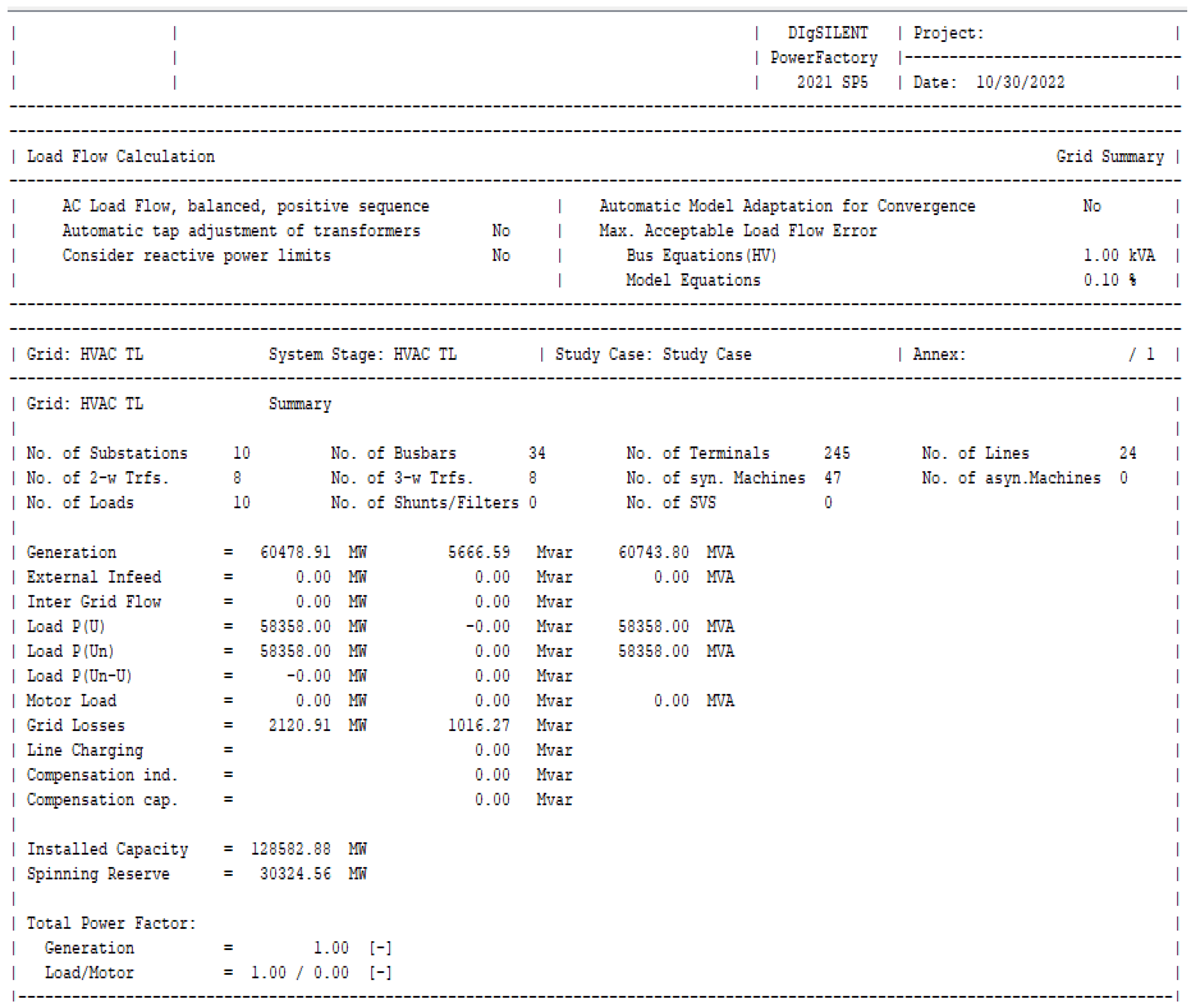

References
- Blyden, B.; Davidson, I. Energizing Africa’s emerging economy. IEEE Power Energy Mag. 2005, 3, 24–31. [Google Scholar] [CrossRef]
- Musaba, L. The development of the SAPP competitive electricity market. In Proceedings of the 2005 IEEE Power Engineering Society Inaugural Conference and Exposition in Africa, Durban, South Africa, 11–15 July 2005; pp. 188–194. [Google Scholar]
- Ndlela, N.W.; Davidson, I.E. Power Planning for a Smart Integrated African Super-Grid. In Proceedings of the 2022 30th Southern African Universities Power Engineering Conference (SAUPEC), Durban, South Africa, 25–27 January 2022; pp. 1–6. [Google Scholar]
- U.S.A Government-Led Partnership. Power Africa Fact Sheet; United State Agency for International Development (USAID): Washington, DC, USA, 2013. Available online: https://www.usaid.gov/powerafrica/countries (accessed on 16 April 2020).
- U.S Energy Information Administration. Energy Information Administration Independent Statistics and Analysis: Washington, DC 20585. 1995. Available online: https://www.eia.gov/international/analysis/country/ARE?scr=email (accessed on 6 May 2020).
- Eskom. Generation. Available online: https://www.eskom.co.za/eskom-divisions/gx/ (accessed on 3 February 2022).
- Valickova, P.; Elms, N. Potential gains from regional integration to reduce costs of electricity supply and access in Southern Africa. Energy Sustain. Dev. 2021, 62, 82–100. [Google Scholar] [CrossRef]
- Jha, P.; Schmidt, S. State of biofuel development in sub-Saharan Africa: How far sustainable? Renew. Sustain. Energy Rev. 2021, 150, 111432. [Google Scholar] [CrossRef]
- Mwale, S.J.; Davidson, I.E. Security analysis of electric power supply in SADC region. In Proceedings of the 2013 Africon, Pointe aux Piments, Mauritius, 9–12 September 2013; pp. 1–6. [Google Scholar]
- Mwale, S.J.T.; Davidson, I.E. A Steady-State Contingency Analysis of the SADC Regional Grid Using the N-1 Criterion. J. Energy Power Eng. 2015, 9, 479–485. [Google Scholar]
- Muntschick, J. The Southern African Development Community (SADC) and the European Union (EU): Regionalism and External Influence; Springer: Berlin/Heidelberg, Germany, 2018. [Google Scholar]
- Chowdhury, A.K.; Deshmukh, R.; Wu, G.C.; Uppal, A.; Mileva, A.; Curry, T.; Armstrong, L.; Galelli, S.; Ndhlukula, K. Enabling a low-carbon electricity system for Southern Africa. Joule 2022, 6, 1826–1844. [Google Scholar] [CrossRef]
- Southern African Power Pool. Energising the Region for Economic Development; SAPP: Harare, Zimbabwe, 2022. [Google Scholar]
- Zimba, S.K.; Nyamutswa, I.; Chikova, A. Islanding power systems to minimize impact of system disturbances in Southern African Power Pool. In Proceedings of the 2017 IEEE AFRICON, Cape Town, South Africa, 18–20 September 2017; pp. 1107–1112. [Google Scholar]
- Korompili, A.; Wu, Q.; Zhao, H. Review of VSC HVDC connection for offshore wind power integration. Renew. Sustain. Energy Rev. 2016, 59, 1405–1414. [Google Scholar] [CrossRef] [Green Version]
- Steinbacher, K.; Schult, H.; Jörling, K.; Fichter, I.T.; Staschus, K.; Schröder, J.; Lenkowski, A.; Germany, N.E. Cross-Border Cooperation for Interconnections and Electricity Trade; Guidehouse: Chicago, IL, USA, 2019. [Google Scholar]
- Hammons, T.; Blyden, B.K.; Calitz, A.C.; Gulstone, A.B.; Isekemanga, E.; Johnstone, R.; Paluku, K.; Simang, N.-N.; Taher, F. African electricity infrastructure interconnections and electricity exchanges. IEEE Trans. Energy Convers. 2000, 15, 470–480. [Google Scholar] [CrossRef]
- Grigsby, L.L. Power System Stability and Control. In The Electric Power Engineering Handbook, 3rd ed.; CRC Press: Boca Raton, FL, USA, 2017; p. 7. [Google Scholar] [CrossRef]
- Nalule, V.R. Regionalism in Addressing Energy Access Challenges. In Energy Poverty and Access Challenges in Sub-Saharan Africa; Palgrave Macmillan: Cham, Switzerland, 2019; pp. 41–89. [Google Scholar]
- Wright, J.G.; Van Coller, J. System adequacy in the Southern African Power Pool: A case for capacity mechanisms. J. Energy South. Afr. 2018, 29, 37–50. [Google Scholar] [CrossRef] [Green Version]
- Procesi, M.; Marini, L.; Cinti, D.; Sciarra, A.; Basile, P.; Mazzoni, T.; Zarlenga, F. Preliminary Fluid Geochemical Survey in Tete Province and Prospective Development of Geothermics in Mozambique. Geotherm. Energy 2022, 10, 2. [Google Scholar] [CrossRef]
- El Yaziji, I. Analysis of Future Energy Scenarios for Mozambique Based on an Integrated Energy-Economy System Optimization Model; Politecnico di Milano: Milan, Italy, 2021. [Google Scholar]
- Turkson, J.; Wohlgemuth, N. Power sector reform and distributed generation in sub-Saharan Africa. Energy Policy 2001, 29, 135–145. [Google Scholar] [CrossRef]
- O’Leary, D.; Charpentier, J.; Minogue, D. Promoting Regional Power Trade: The Southern African Power Pool; World Bank Group: Washington, DC, USA, 1998; p. 4. [Google Scholar]
- Willis, H.L.; Scott, W.G. Distributed Power Generation: Planning and Evaluation; CRC Press: Boca Raton, FL, USA, 2018. [Google Scholar]
- Mwale, S.; Davidson, I. SADC Power Grid Reliability—A Steady-state Contingency Analysis and Strategic HVDC Interconnections Using the N-1 Criterion. In Proceedings of the 2nd International Symposium on Energy Challenges and Mechanics, Aberdeen, UK, 21–22 August 2019; pp. 19–21. [Google Scholar]
- Zhao, Q.; García-González, J.; García-Cerrada, A.; Renedo, J.; Rouco, L. HVDC in the Future Power Systems. In Transmission Expansion Planning: The Network Challenges of the Energy Transition; Springer: Berlin/Heidelberg, Germany, 2021; pp. 117–151. [Google Scholar]
- Xue, Y.; Kong, D.; Song, Z.; Hamidi, V.; Zhang, X.-P. Development of an Advanced LCC-HVDC Model for Transmission System. In Proceedings of the 11th IET International Conference on AC and DC Power Transmission, Birmingham, UK, 10–12 February 2015; pp. 1–5. [Google Scholar]
- Blarke, M.B.; Jenkins, B.M. SuperGrid or SmartGrid: Competing strategies for large-scale integration of intermittent renewables? Energy Policy 2013, 58, 381–390. [Google Scholar] [CrossRef]
- Arestova, A.; Sidorkin, Y. The use of wind farms and virtual power plants for emergency control in the future smart super grids. In Proceedings of the 2011 6th International Forum on Strategic Technology, Harbin, China, 22–24 August 2011; pp. 437–442. [Google Scholar]
- Noor, S.; Yang, W.; Guo, M.; van Dam, K.H.; Wang, X. Energy demand side management within micro-grid networks enhanced by blockchain. Appl. Energy 2018, 228, 1385–1398. [Google Scholar] [CrossRef]
- Bansal, R. Power System Protection in Smart Grid Environment, 1st ed.; CRC Press: Boca Raton, FL, USA; London, UK; New York, NY, USA, 2019. [Google Scholar]
- Nadeem, M.; Imran, K.; Khattak, A.; Ulasyar, A.; Pal, A.; Zeb, M.Z.; Khan, A.N.; Padhee, M. Optimal placement, sizing and coordination of FACTS devices in transmission network using whale optimization algorithm. Energies 2020, 13, 753. [Google Scholar] [CrossRef] [Green Version]
- Sudeep, G.; Suryanarayanareddy, V. Improvement of Voltage Stability by Placing UPFC using fuzzy Logic. Int. Res. J. Eng. Technol. (IRJET) 2019, 6, 2106–2112. [Google Scholar]
- Kincic, S.; Wan, X.T.; McGillis, D.T.; Chandra, A.; Ooi, B.-T.; Galiana, F.D.; Joos, G. Voltage support by distributed static VAr systems (SVS). IEEE Trans. Power Deliv. 2005, 20, 1541–1549. [Google Scholar] [CrossRef]
- Mwale, S.J.T. The Southern African Power Pool (SAPP) Steady State Security Assessment Using Contigency Analysis, Master of Science in Electrical Engineering; Department of Electrical Engineering, University of KwaZulu-Natal: Durban, South Africa, 2015. [Google Scholar]
- SAPP. SAPP Transmission Planning Criteria. 2012. Available online: https://www.sacreee.org/sites/default/files/training/files/SAPP%20Transmission%20Planning%20Criteria_JAN%202012.pdf (accessed on 12 January 2023).
- Tao, S.; Zhang, Y.; Yuan, M.; Zhang, R.; Xu, Z.; Sun, Y. Behavioral Economics Optimized Renewable Power Grid: A Case Study of Household Energy Storage. Energies 2021, 14, 4154. [Google Scholar] [CrossRef]
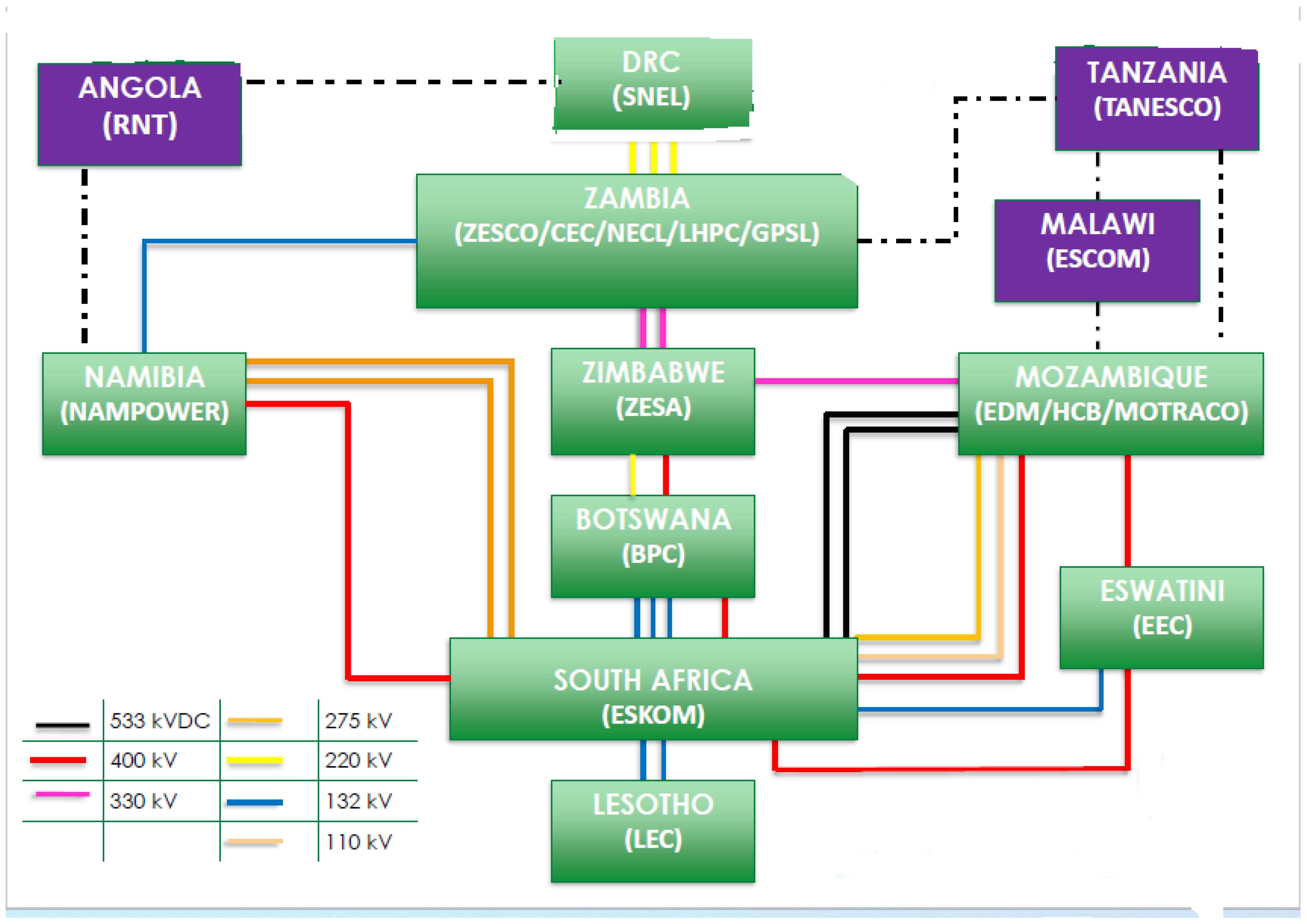
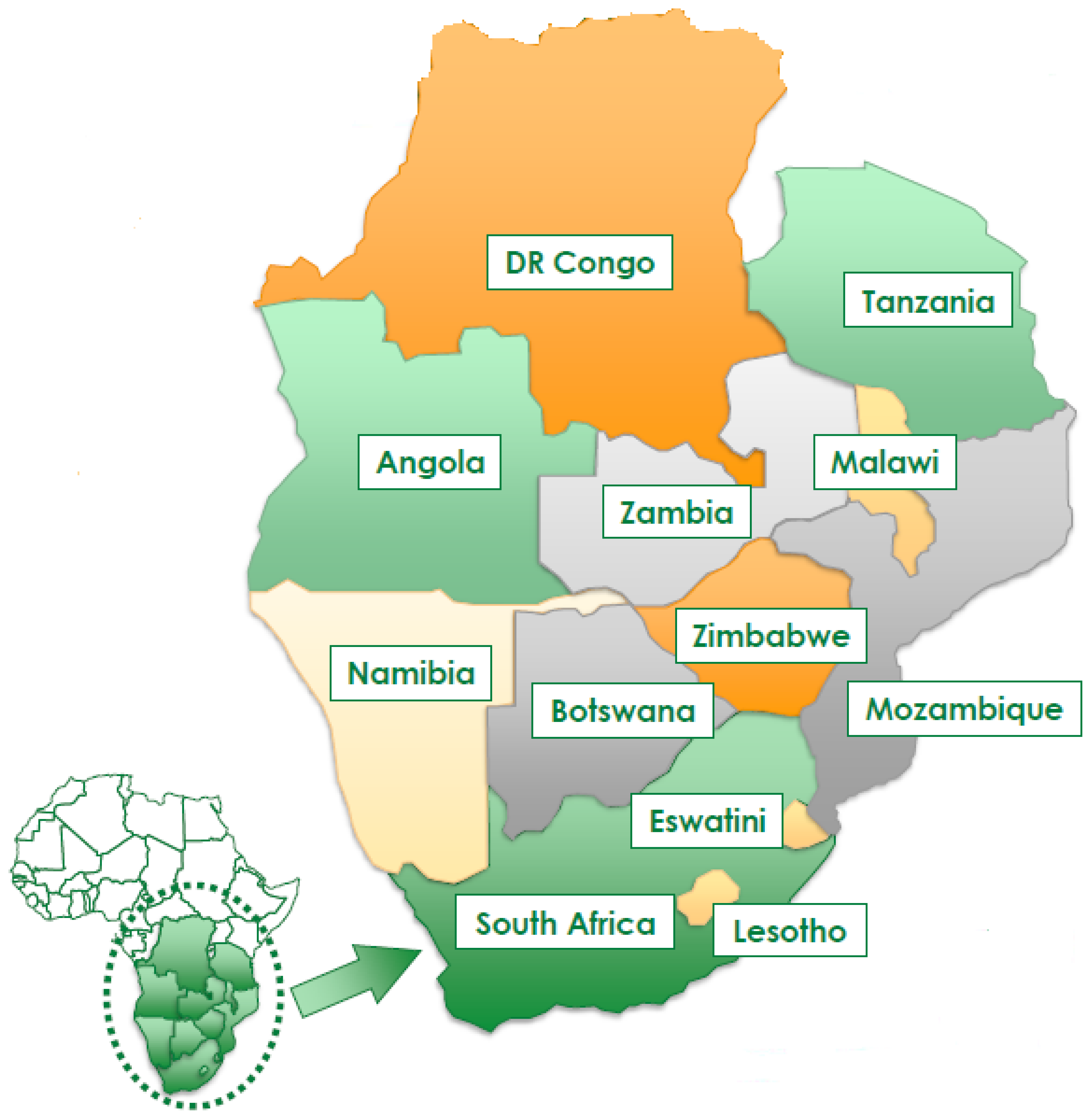

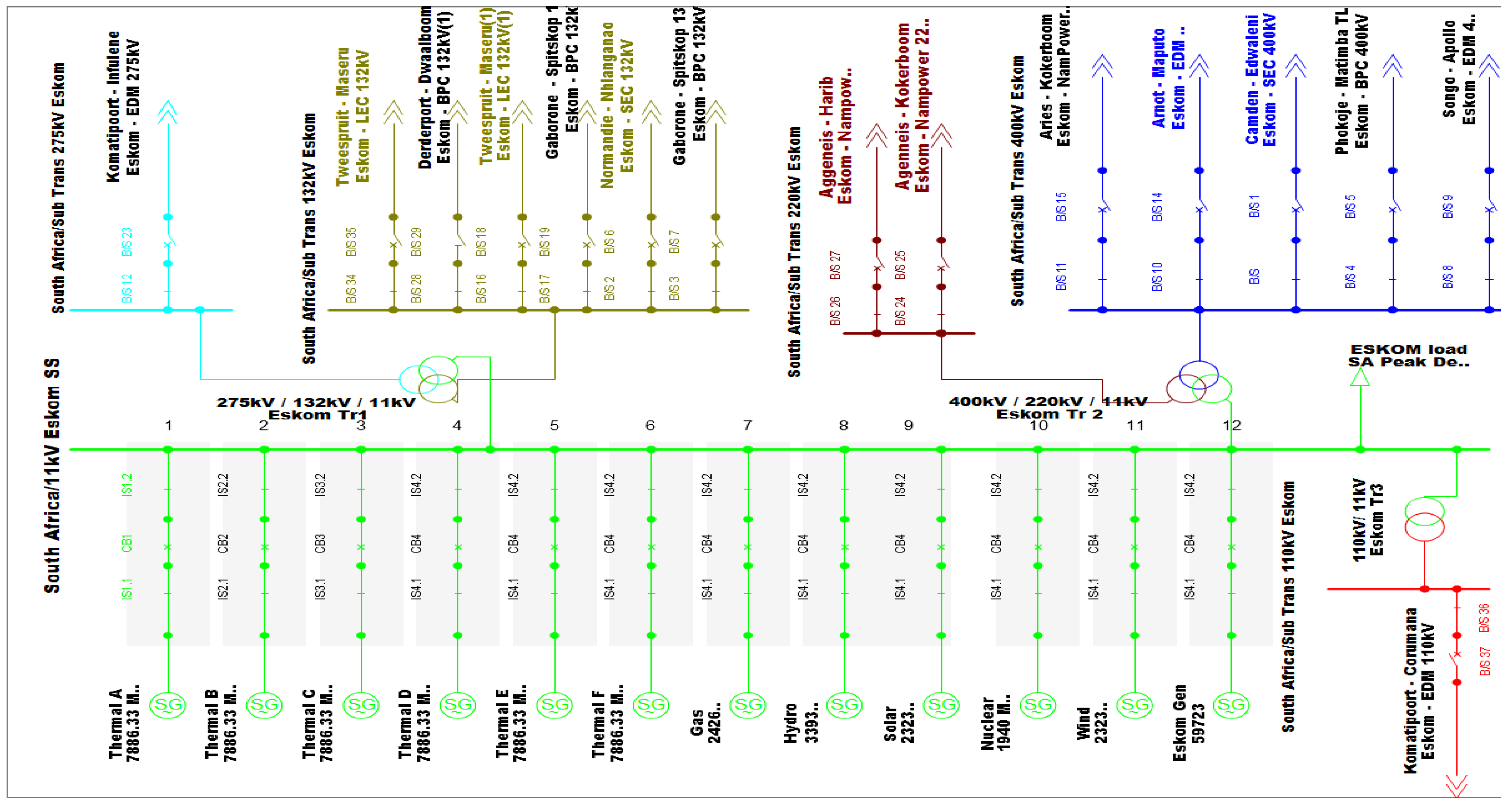

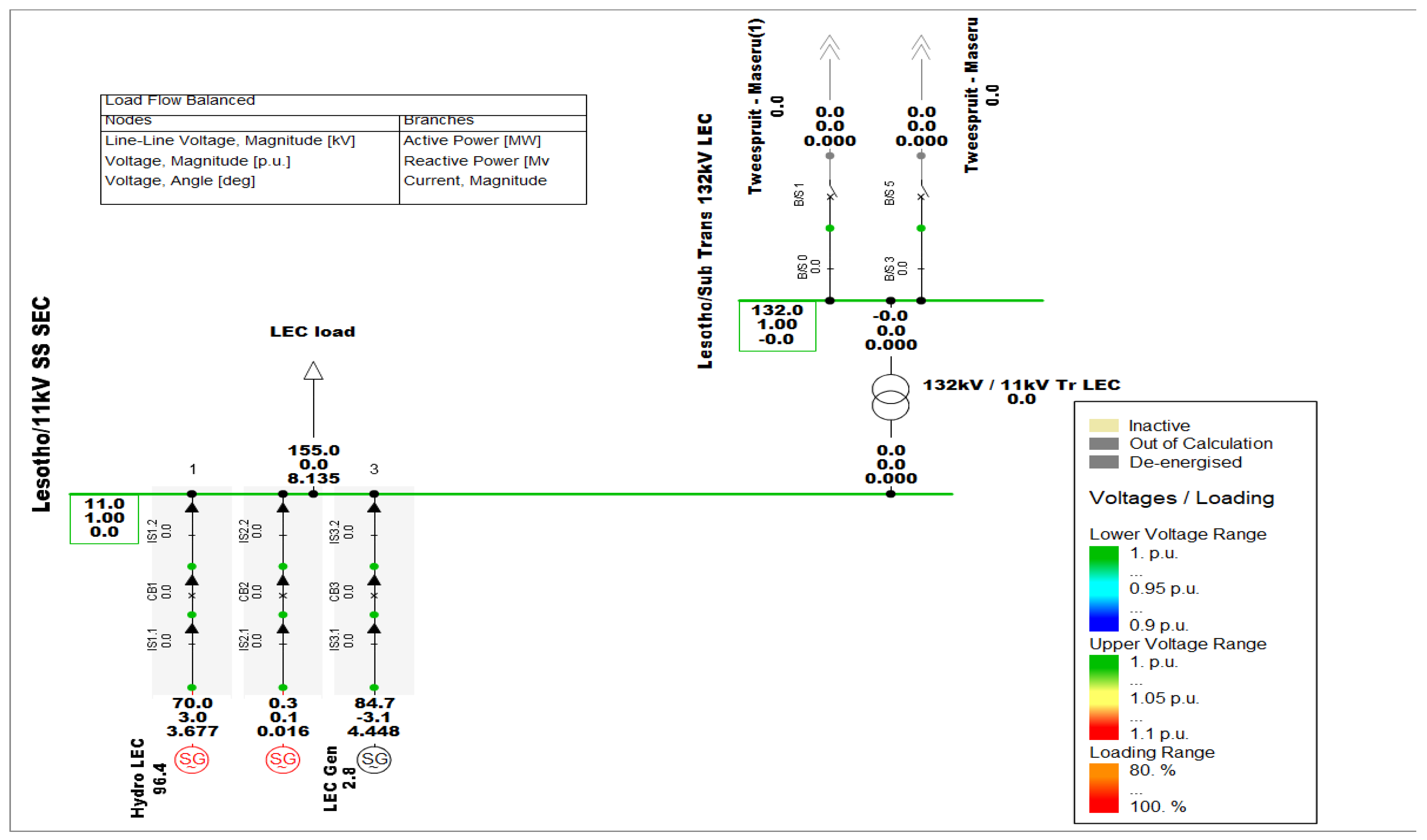
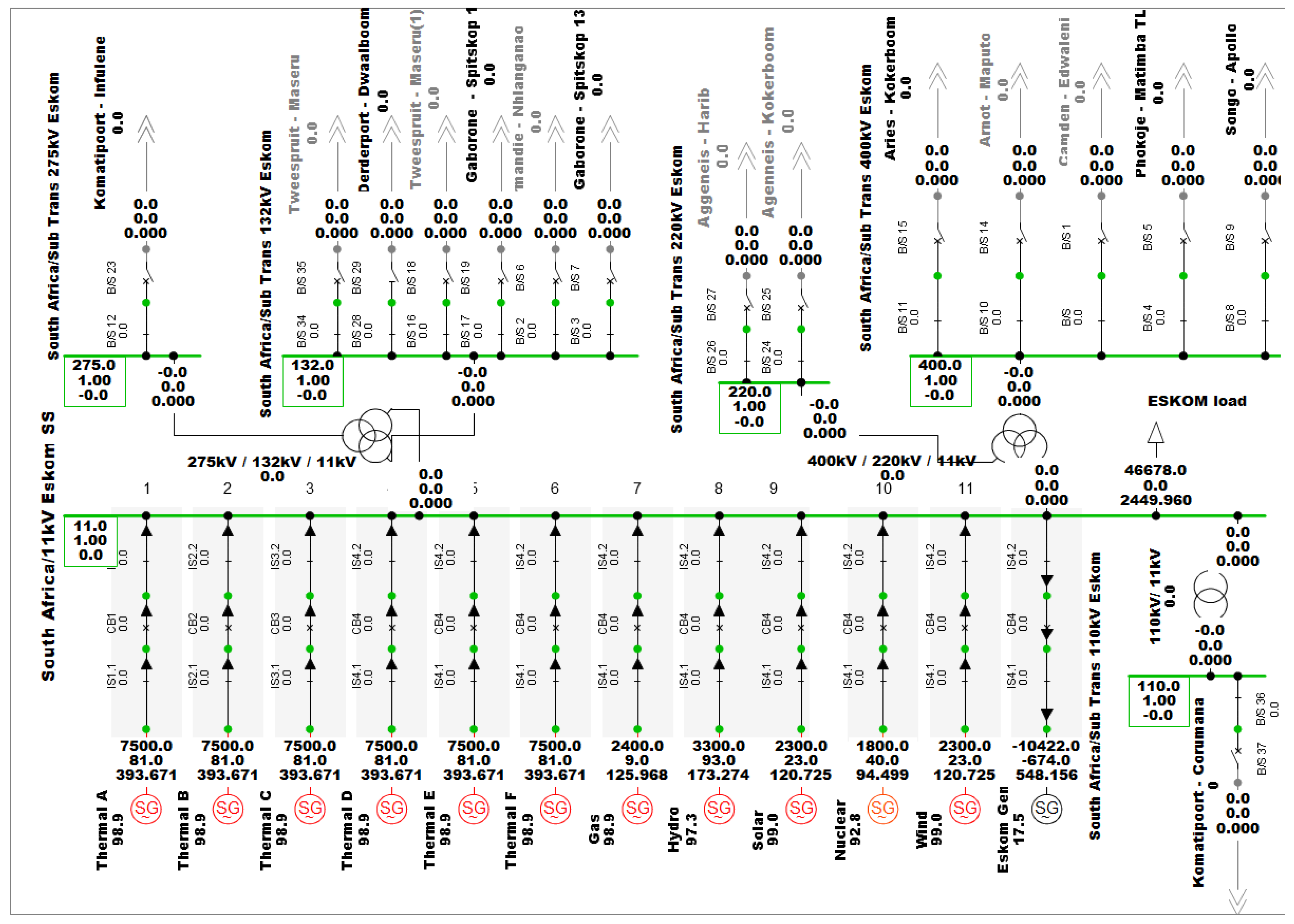

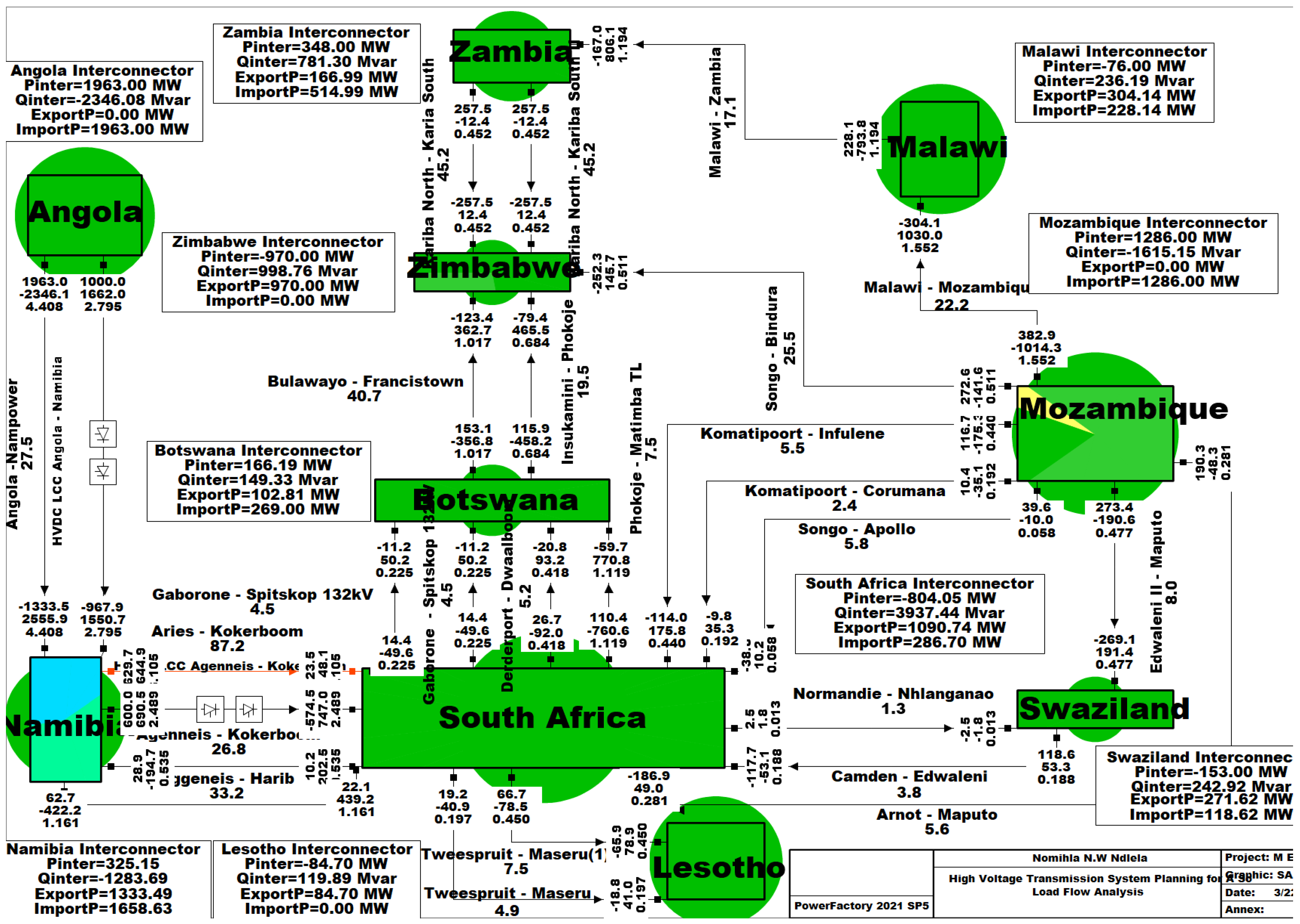
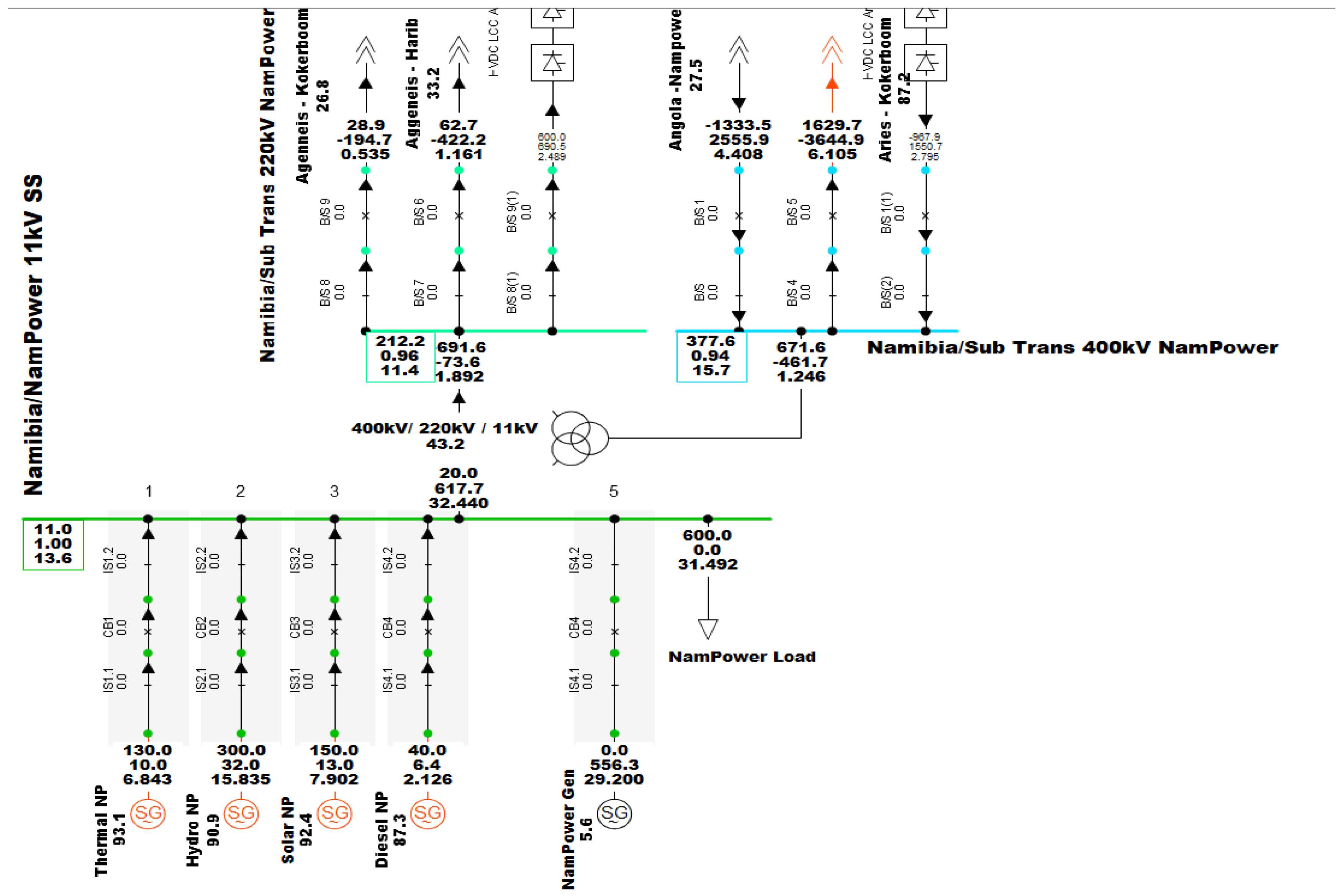

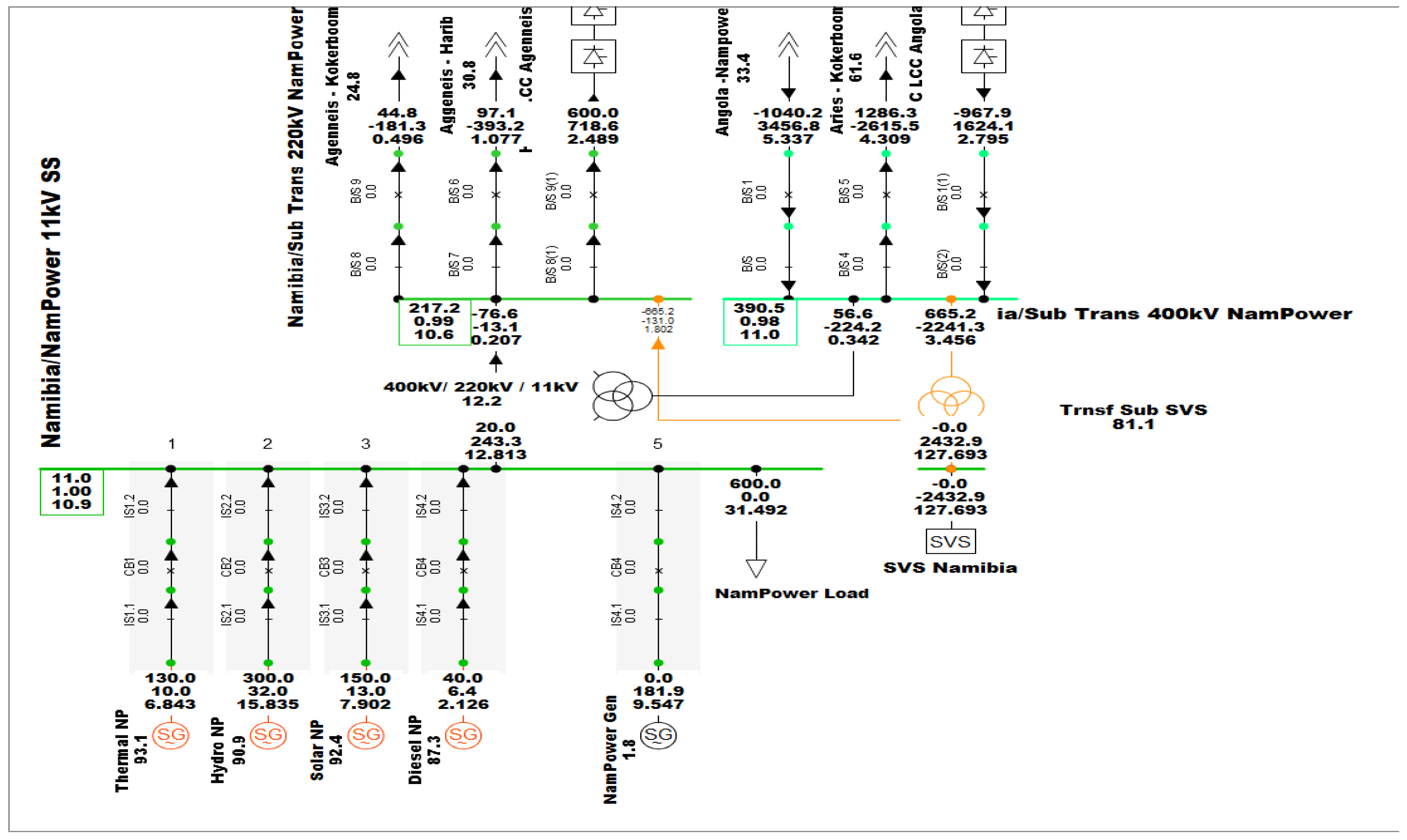

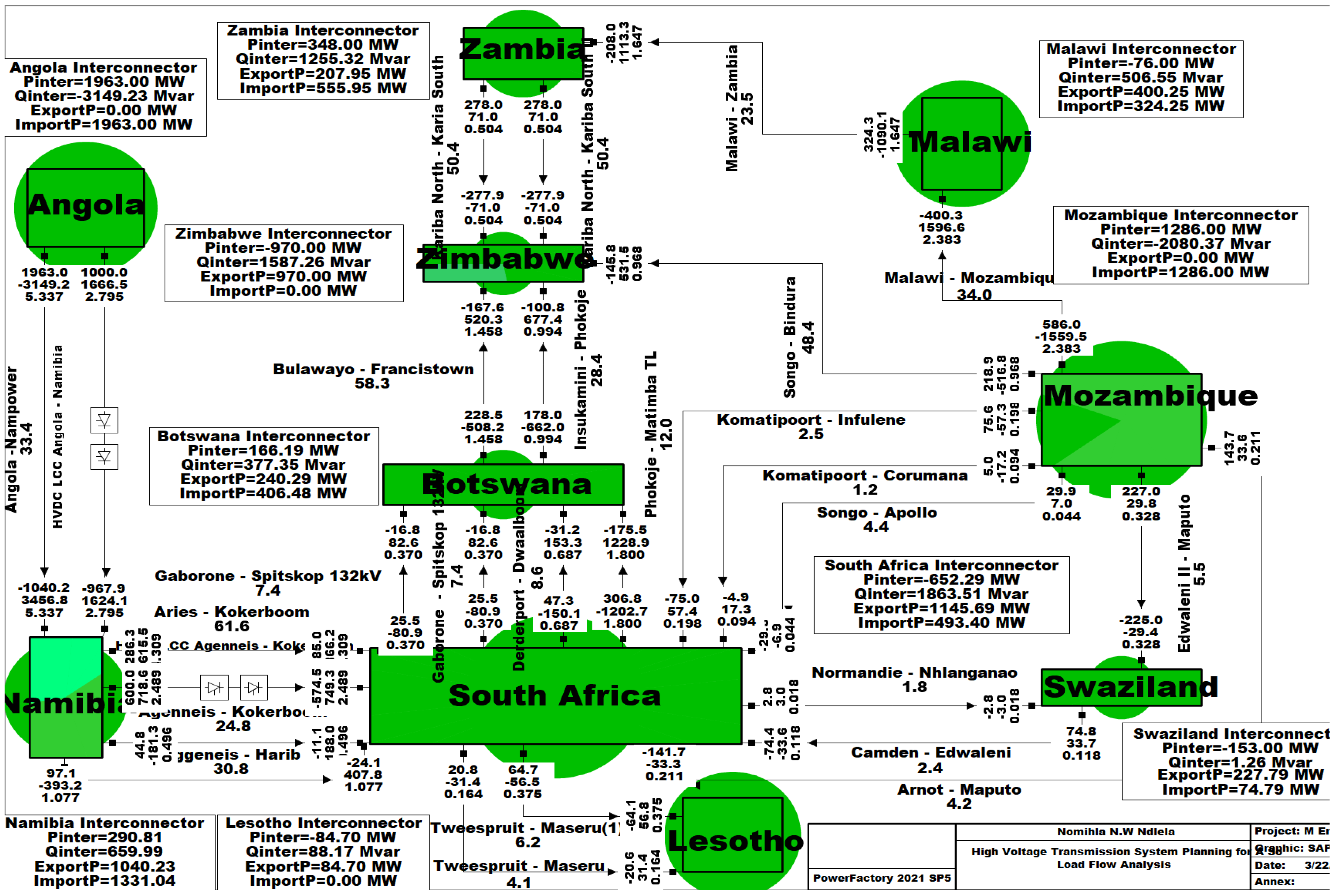
| Coal-Fired Plants | Installed Capacity (MW) | Hydroelectricity | Installed Capacity (MW) |
|---|---|---|---|
| Arnot | 2100 | Conventional hydro stations | |
| Camden | 1561 | Gariep | 360 |
| Duvha | 3600 | Vanderkloof | 240 |
| Grootvelei | 1200 | Pumped storage schemes | |
| Hendrina | 2000 | Drakensberg | 1000 |
| Kendal | 4116 | Palmiet | 400 |
| Komati | 1000 | Ingula | 1332 |
| Kriel | 2850 | Other hydropower Stations | |
| Lethabo | 3708 | Colley Wobbles | 42 |
| Majuba | 4110 | Second Falls | 11 |
| Matimba | 3990 | First Falls | 6 |
| Matla | 3600 | Ncora | 2.4 |
| Tutuka | 3654 | Other renewable energy stations | |
| Medupi | 4800 | Sere Wind Facility | 106 |
| Kusile | 3200 | ||
| Gas/Liquid turbine stations | Nuclear | ||
| Acacia | 171 | Koeberg | 1840 |
| Port Rex | 171 | ||
| Ankerlig | 1327 | ||
| Gourikwa | 740 | ||
| Independent Power Producers (Solar and Wind) | 5027 | ||
| Total Installed Capacity (existing) | 58,108.4 | ||
| Eskom Planned capacity additions (Kusile units 5 & 6) | 1600 | ||
| Country | Thermal | Gas | Hydro | Solar | Nuclear | Wind | Oil | Diesel | Total (MW) |
|---|---|---|---|---|---|---|---|---|---|
| South Africa | 45,489 | 2409 | 3393.4 | 2323 | 1840 | 2323 | 57,777.4 | ||
| Angola | 243 | 5901.46 | 35 | 95 | 136 | 6410.46 | |||
| Mozambique | 800 | 2206 | 40 | 3046 | |||||
| Botswana | 822 | 1.3 | 70 | 893.3 | |||||
| Lesotho | 72.67 | 0.305 | 72.975 | ||||||
| Malawi | 370.35 | 36 | 406.35 | ||||||
| Namibia | 120 | 332 | 163 | 46.4 | 661.4 | ||||
| Swaziland | 78.1 | 78.1 | |||||||
| Zambia | 405 | 2294.5 | 54 | 8.85 | 2762.35 | ||||
| Zimbabwe | 1130 | 1140 | 2270 | ||||||
| Total | 48,766 | 2652 | 15,788.48 | 2616.6 | 1840 | 2323 | 95 | 297.25 | 74,378.36 |
| Country | Power Demand (MW) | Current Access (%) |
|---|---|---|
| South Africa | 46,678 | 95 |
| Angola | 3378.65 | 45 |
| Mozambique | 1650.5 | 29 |
| Botswana | 702 | 56 |
| Lesotho | 155 | 44.64 |
| Malawi | 470 | 11 |
| Namibia | 600 | 56 |
| Swaziland | 223 | 87 |
| Zambia | 2300 | 31 |
| Zimbabwe | 2200 | 41.9 |
| Busbar Name | (a) HVAC (p.u) | (b) HVDC Link (p.u) | (c) HVDC & SVC (p.u) |
|---|---|---|---|
| Angola 11 kV | 1.00 | 1.00 | 1.00 |
| Angola 400 kV | 1.01 | 1.00 | 1.00 |
| Namibia 11 kV | 1.00 | 1.00 | 1.00 |
| Namibia 220 kV | 1.02 | 0.96 | 0.99 |
| Namibia 400 kV | 0.94 | 0.94 | 0.98 |
| South Africa 11 kV | 1.00 | 1.00 | 1.00 |
| South Africa 275 kV | 1.00 | 1.00 | 1.00 |
| South Africa 132 kV | 1.00 | 1.00 | 1.00 |
| South Africa 220 kV | 1.00 | 0.99 | 1.00 |
| South Africa 400 kV | 0.99 | 0.99 | 1.00 |
| South Africa 110 kV | 1.00 | 1.00 | 1.00 |
| Lesotho 11 kV | 1.00 | 1.00 | 1.00 |
| Lesotho 132 kV | 1.00 | 1.00 | 1.00 |
| Botswana 11 kV | 1.00 | 1.00 | 1.00 |
| Botswana 400 kV | 1.00 | 1.00 | 1.00 |
| Botswana 220 kV | 1.00 | 1.00 | 1.00 |
| Botswana 132 kV | 1.00 | 1.00 | 1.00 |
| Swaziland 11 kV | 1.00 | 1.00 | 1.00 |
| Swaziland 400 kV | 1.00 | 1.00 | 1.00 |
| Swaziland 132 kV | 1.00 | 1.00 | 1.00 |
| Mozambique 11 kV | 1.00 | 1.00 | 1.00 |
| Mozambique 400 kV | 1.01 | 1.01 | 1.01 |
| Mozambique 330 kV | 1.05 | 1.05 | 1.01 |
| Mozambique 275 kV | 1.01 | 1.00 | 1.00 |
| Mozambique 110 kV | 1.00 | 1.00 | 1.00 |
| Malawi 11 kV | 1.00 | 1.00 | 1.00 |
| Malawi 400 kV | 1.00 | 1.00 | 1.00 |
| Zimbabwe 11 kV | 1.00 | 1.00 | 1.00 |
| Zimbabwe 400 kV | 1.00 | 1.00 | 0.99 |
| Zimbabwe 330 kV | 1.00 | 1.00 | 1.00 |
| Zimbabwe 220 kV | 0.99 | 0.99 | 0.98 |
| Zambia 11 kV | 1.00 | 1.00 | 1.00 |
| Zambia 400 kV | 1.00 | 1.00 | 1.00 |
| Zambia 330 kV | 1.00 | 1.00 | 0.99 |
| Transmission Line Name | (a) HVAC (%) | (b) HVDC (%) | (c) HVDC & SVC (%) |
|---|---|---|---|
| Aggeneys–Kokerboom | 28.80 | 26.77 | 24.82 |
| Aggeneys–Harib | 35.69 | 33.18 | 30.76 |
| Angola–Nampower | 41.79 | 27.55 | 33.35 |
| Aries–Kokerboom | 76.42 | 87.21 | 61.56 |
| Arnot–Maputo | 5.82 | 5.62 | 4.22 |
| Bulawayo–Francistown | 40.66 | 40.67 | 58.31 |
| Camden–Edwaleni | 3.27 | 3.76 | 2.37 |
| Derderport–Dwaalboom | 4.91 | 5.23 | 8.59 |
| Edwaleni II–Maputo | 7.73 | 7.95 | 5.46 |
| Gaborone–Spitskop 132 kV | 4.24 | 4.51 | 7.40 |
| Gaborone–Spitskop 132 kV | 4.23 | 4.51 | 7.40 |
| Insukamini–Phokoje | 19.54 | 19.54 | 28.39 |
| Kariba North–Karia South | 45.23 | 45.21 | 50.41 |
| Kariba North–Kariba South II | 45.23 | 45.21 | 50.41 |
| Komatipoort–Corumana | 2.78 | 2.40 | 1.18 |
| Komatipoort–Infulene | 6.47 | 5.50 | 2.48 |
| Malawi–Mozambique | 21.84 | 22.18 | 34.04 |
| Malawi–Zambia | 16.99 | 17.05 | 23.52 |
| Normandie–Nhlanganao | 2.59 | 1.33 | 1.80 |
| Phokoje–Matimba TL | 6.94 | 7.4 | 12.00 |
| Songo–Apollo | 6.05 | 5.84 | 4.39 |
| Songo–Bindura | 25.30 | 25.55 | 48.42 |
| Tweespruit–Maseru | 5.09 | 4.93 | 4.11 |
| Tweespruit–Maseru (1) | 7.75 | 7.50 | 6.25 |
| Transmission Line Name | (a) HVAC (MW) | (b) HVDC Link (MW) | (c) HVDC & SVC (MW) |
|---|---|---|---|
| Aggeneys–Kokerboom | 45.3 | 18.7 | 33.7 |
| Aggeneys–Harib | 98.2 | 40.6 | 73 |
| Angola–Nampower | 1448.3 | 629.5 | 922.8 |
| Aries–Kokerboom | 772.6 | 1006.2 | 201.3 |
| Arnot–Maputo | 3.7 | 3.4 | 2 |
| Bulawayo–Francistown | 29.6 | 29.7 | 60.9 |
| Camden–Edwaleni | 0.7 | 0.9 | 0.4 |
| Derderport–Dwaalboom | 5.30 | 5.9 | 16.1 |
| Edwaleni II–Maputo | 4.00 | 4.3 | 2 |
| Gaborone–Spitskop 132 kV | 2.80 | 3.2 | 8.7 |
| Gaborone–Spitskop 132 kV | 2.80 | 3.2 | 8.7 |
| Insukamini–Phokoje | 36.5 | 36.5 | 77.2 |
| Kariba North–Karia South | 00 | 00 | 0.1 |
| Kariba North–Kariba South II | 00 | 00 | 0.1 |
| Komatipoort–Corumana | 0.7 | 0.6 | 0.1 |
| Komatipoort–Infulene | 3.8 | 2.7 | 0.6 |
| Malawi–Mozambique | 76.4 | 78.8 | 185.7 |
| Malawi–Zambia | 60.7 | 61.1 | 116.3 |
| Normandie–Nhlanganao | 0.1 | 0 | 0 |
| Phokoje–Matimba TL | 43.8 | 50.7 | 131.3 |
| Songo–Apollo | 0.8 | 0.8 | 0.4 |
| Songo–Bindura | 20 | 20.3 | 73.1 |
| Tweespruit–Maseru | 0.4 | 0.8 | 0.6 |
| Tweespruit–Maseru (1) | 0.9 | 0.4 | 0.2 |
| HVDC LCC Angola–Nampower | - | 32.1 | 32.1 |
| HVDC LCC Aggeneys–Kokerboom | - | 25.2 | 25.2 |
| Total |
Disclaimer/Publisher’s Note: The statements, opinions and data contained in all publications are solely those of the individual author(s) and contributor(s) and not of MDPI and/or the editor(s). MDPI and/or the editor(s) disclaim responsibility for any injury to people or property resulting from any ideas, methods, instructions or products referred to in the content. |
© 2023 by the authors. Licensee MDPI, Basel, Switzerland. This article is an open access article distributed under the terms and conditions of the Creative Commons Attribution (CC BY) license (https://creativecommons.org/licenses/by/4.0/).
Share and Cite
Ndlela, N.W.; Davidson, I.E.; Moloi, K. Power Planning for a Reliable Southern African Regional Grid. Energies 2023, 16, 1028. https://doi.org/10.3390/en16031028
Ndlela NW, Davidson IE, Moloi K. Power Planning for a Reliable Southern African Regional Grid. Energies. 2023; 16(3):1028. https://doi.org/10.3390/en16031028
Chicago/Turabian StyleNdlela, Nomihla Wandile, Innocent Ewean Davidson, and Katleho Moloi. 2023. "Power Planning for a Reliable Southern African Regional Grid" Energies 16, no. 3: 1028. https://doi.org/10.3390/en16031028
APA StyleNdlela, N. W., Davidson, I. E., & Moloi, K. (2023). Power Planning for a Reliable Southern African Regional Grid. Energies, 16(3), 1028. https://doi.org/10.3390/en16031028







